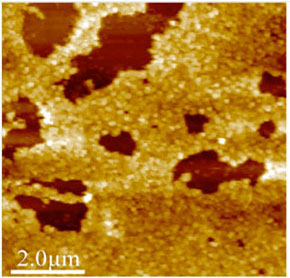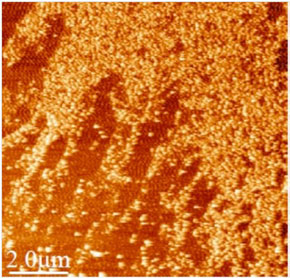| Posted: Jun 11, 2010 | |
Artificial antibodies made from plastic shown to work in living animals |
|
| (Nanowerk Spotlight) Antibodies are certain types of protein that are found in blood or other bodily fluids and are used by the immune system to identify and neutralize potentially harmful foreign objects such as bacteria, viruses, and other microorganisms. The ability of an antibody to recognize a specific target molecule depends on a small region of the antibody – the antigen-binding site – that responds only to a certain protein – the antigen – on the surface of the foreign object. The antigen-binding site is extremely variable, allowing a vast number of antibodies with slightly different antigen-binding sites, to exist. | |
| In order to facilitate nanotechnology applications in medicine and biology, scientists routinely are conjugating nanoparticles with biomacromolecular ligands. A more direct approach, where its chemical composition determines a nanoparticle's affinity to specific biomacromolecules, has not been explored a great deal yet. Nevertheless, synthetic polymer nanoparticles capable of binding to specific biomacromolecules are of significant interest as substitutes for antibodies. Such particles can be utilized as inexpensive and stable functional materials for medicine, drug targeting, separations, biosensors, diagnostics, and antidotes for toxins and viruses. | |
| A U.S.-Japanese research team has now developed methods for synthesizing protein-sized polymer particles with a binding affinity and selectivity comparable to those of natural antibodies by combining molecular imprinting nanoparticle synthesis with a functional monomer optimization strategy. | |
| In effect, they have created a plastic antibody, an artificial version of the real thing. They have also demonstrated that it works in the bloodstream of a living animal. | |
| As a result, we can now consider synthetic polymer nanoparticles, prepared by an abiotic process in the chemical laboratory, as alternatives to biological macromolecules. Applications could include antidotes for toxins, protein purification and therapies that currently use antibodies. | |
| "I believe the key finding of our recent work is that a synthetic polymer nanoparticle can function with antibody-like affinity and selectivity in a living organism to capture and neutralize a peptide toxin," Kenneth J. Shea tells Nanowerk. "Antibody-like affinity means the ability to bind a specific target molecule (like a peptide or protein) but have little affinity (selectivity) for other molecules (the lock and key analogy)." | |
  |
|
| AFM images of the plastic antibodies (Images: Dr. Shea, University of California, Irvine) | |
| Shea, a professor of chemistry at the University of California, Irvine, together with Dr. Yu Hoshino and collaborators from the University of Shizuoka in Japan (Naoto Oku's group), have published their findings in a recent edition of Journal of the American Chemical Society ("Recognition, Neutralization, and Clearance of Target Peptides in the Bloodstream of Living Mice by Molecularly Imprinted Polymer Nanoparticles: A Plastic Antibody"). | |
| Shea explains that his team and others have previously prepared synthetic polymers that can recognize and bind to another molecule. However, the recognition often takes place under highly controlled laboratory conditions. In order to function in a biological environment such as the blood stream, the recognition and binding by the synthetic nanoparticle must take place in the presence in a sea of competing molecules (proteins, peptides, cells, etc.). | |
| "The polymer nanoparticle must avoid being cleared by the natural filtering systems of the blood and must not trigger an immune responses" he says. "All of these present formidable challenges for the design of a nanoparticle. Our present work demonstrates that these challenges can be overcome." | |
| To fabricate their plastic antibodies, the team uses an approach called molecular imprinting, a process similar to leaving a footprint in wet concrete. For these particular experiments, they chose melittin – the principal active component of bee venom and a well-studied biotoxin – as the target and imprint molecule. They mixed it with a monomer solution and then started a chemical reaction that links these building blocks into long chains, and makes them solidify. When the plastic particles hardened, the researchers leached the melittin out. That left the polymer nanoparticles with tiny melittin-shaped craters, i.e. melittin-imprinted polymer nanoparticles. | |
| The researchers tested the efficacy of their plastic antibodies in vivo on mice. Mice were injected intravenously with a high dose of melittin and then intravenously with the synthesized polymer antibodies. A control group that did not receive the antibody injection showed a 100% mortality rate. The group that received the plastic antibodies showed a significantly reduced mortality rate as well as a significant reduction in peritoneal inflammation caused by melittin. The melittin - plastic antibody complexes were then cleared from the blood by the mononuclear phagocytic system in the liver. | |
| "From our results we conclude that imprinted polymer nanoparticles efficiently capture the cytotoxic peptide melittin in the bloodstream," says Shea. "The strong and specific affinity of the imprinted nanoparticles enabled the rapid sequestration of the target peptide in the biological milieu." | |
| He points out that his team's results establish for the first time that a simple, nonbiological synthetic nanoparticle with antibody-like affinity and selectivity can effectively function in the bloodstream of living animals. | |
 By
Michael
Berger
– Michael is author of three books by the Royal Society of Chemistry:
Nano-Society: Pushing the Boundaries of Technology,
Nanotechnology: The Future is Tiny, and
Nanoengineering: The Skills and Tools Making Technology Invisible
Copyright ©
Nanowerk LLC
By
Michael
Berger
– Michael is author of three books by the Royal Society of Chemistry:
Nano-Society: Pushing the Boundaries of Technology,
Nanotechnology: The Future is Tiny, and
Nanoengineering: The Skills and Tools Making Technology Invisible
Copyright ©
Nanowerk LLC
|
|
|
Become a Spotlight guest author! Join our large and growing group of guest contributors. Have you just published a scientific paper or have other exciting developments to share with the nanotechnology community? Here is how to publish on nanowerk.com. |
|
